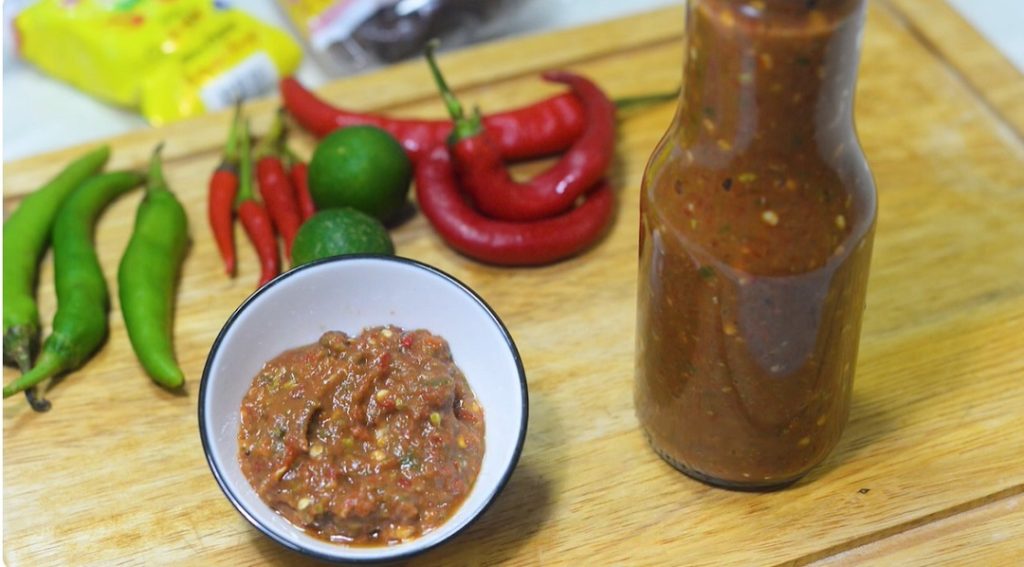
Introduction of Sambal Belacan/ Belacan Chili
Resepi Sambal Belacan sedap simple, the embodiment of Malaysia’s love for fiery flavors, is a condiment that adds a tantalizing punch to countless dishes. Rooted in tradition, this versatile condiment is a testament to Malaysia’s rich culinary heritage. Today, we’ll take you through crafting your own Sambal Belacan Kampung sedap simple using a blend of essential ingredients that capture the true essence of Malaysian cuisine.
Ingredients
- 100g Tamarind (Asam Jawa)
- 100g Hot Water
- 65g Green Chilies
- 65g Red Chilies
- 8g Small Chili Padi
- Juice of 5 Calamansi
- 50g Toasted Belacan (Shrimp Paste)
- 30g Sugar
- 3g Salt
Instruction of Sambal Belacan Sedap
- Tamarind Infusion: Mixing 100g of tamarind with an equal amount of hot water. Stir well to allow the tamarind to infuse with the hot water. After a few minutes, strain the mixture to extract the tamarind juice. You should end up with approximately 100g of tamarind juice.
- Blend it All: Prepare all ingredients – green chilies, red chilies, small chili padi, calamansi juice, toasted belacan, sugar, and salt. after that add into blender. The tamarind juice, which holds the essence of this condiment, joins the party as well.
- The Art of Blending: Let the blender work its magic for about a minute. The result should be a harmonious blend of flavors – the fiery chilies, the depth of belacan, the tangy tamarind, and the hint of sweetness from the sugar.
- Ready to Serve: That’s it! Your Sambal Belacan Kampung sedap simple is ready to elevate your dishes. The simplicity and speed of this recipe are a testament to the ease of creating a vibrant condiment that holds the heart of Malaysian cuisine. Enjoy the bold flavors, the fiery kick, and the cultural richness that this sambal brings to your table.
More video
Summary/ Conclusion of Sambal Belacan
Sambal Belacan Kampung is more than a condiment; it’s a representation of Malaysia’s culinary heritage, where bold flavors and a passion for spice come together. Crafting this sambal from scratch allows you to experience the authentic essence of Malaysian cuisine. So, the next time you’re looking to add a burst of flavor to your meal, reach for your homemade Sambal Belacan Kampung and savor the tradition that makes it a quintessential part of Malaysian culture.
Story and History about Sambal Belacan
Sambal Belacan: A Fiery Journey through Malaysian Culinary History
Sambal Belacan, a ubiquitous and fiery condiment in Malaysian cuisine, has a rich history that spans centuries. It is a vital element of Malaysian gastronomy, representing a tantalizing fusion of flavors, cultures, and culinary traditions.
Ancient Origins:
The history of Sambal Belacan can be traced back to the early centuries of the Malay archipelago. The origins of Sambal Belacan are intertwined with the culinary practices of the indigenous Malays, who inhabited the coastal regions of present-day Malaysia and Indonesia. The word “sambal” itself is derived from the Malay term “sembel,” which means “sauce.”
Belacan – The Essential Ingredient:
Shrimp paste, key ingredients, also known as fermented product made from tiny shrimp or krill. It is sun-dried, then compacted into cakes or blocks, creating a potent umami-rich condiment. The history of belacan traces back to ancient Southeast Asian communities, where it was used for its preservative properties, making it an essential ingredient for seafaring and trade.
Culinary Fusion:
The beauty of Sambal Belacan lies in its versatility and adaptability. Over the centuries, it has absorbed influences from various cultures, including Chinese, Indian, and Thai, due to Malaysia’s strategic location along ancient spice trade routes. These culinary interactions enriched the flavors of Sambal Belacan, resulting in the diverse regional variations seen across Malaysia today.
Regional Distinctions:
Each region in Malaysia has its unique take on Sambal Belacan. For instance, in the southern state of Johor, Sambal Belacan often incorporates more herbs and lime juice. In Penang, tamarind and shrimp paste are combined to create a tangy and pungent version. In Sarawak, the addition of bird’s eye chilies intensifies the heat. This diversity is a testament to Malaysia’s multicultural society and the dynamic evolution of its cuisine.
Cultural Significance:
Beyond its culinary importance, Sambal Belacan carries cultural significance. It plays a central role in Malaysian gatherings and celebrations, symbolizing togetherness and shared identity. A meal isn’t complete without a side of Sambal Belacan, be it with rice, noodles, or various traditional dishes like nasi lemak, rendang, or laksa. It also can be cook to become nasi goreng belacan, mee goreng belacan.
Today and Beyond of Sambal Belacan Sedap:
Sambal Belacan remains a beloved and indispensable element of Malaysian cuisine. Its complex, fiery, and umami-rich flavors continue to inspire chefs and food enthusiasts globally. While traditions persist, contemporary interpretations and fusion creations featuring Sambal Belacan ensure its relevance in the ever-evolving culinary landscape.
In conclusion, Sambal Belacan is more than a condiment; it is a culinary embodiment of Malaysia’s rich history and cultural diversity. It showcases the adaptability of flavors over centuries and the unifying power of food in a multicultural society. Sambal Belacan is a testament to Malaysia’s culinary heritage, both deeply rooted in tradition and dynamic in its evolution.
